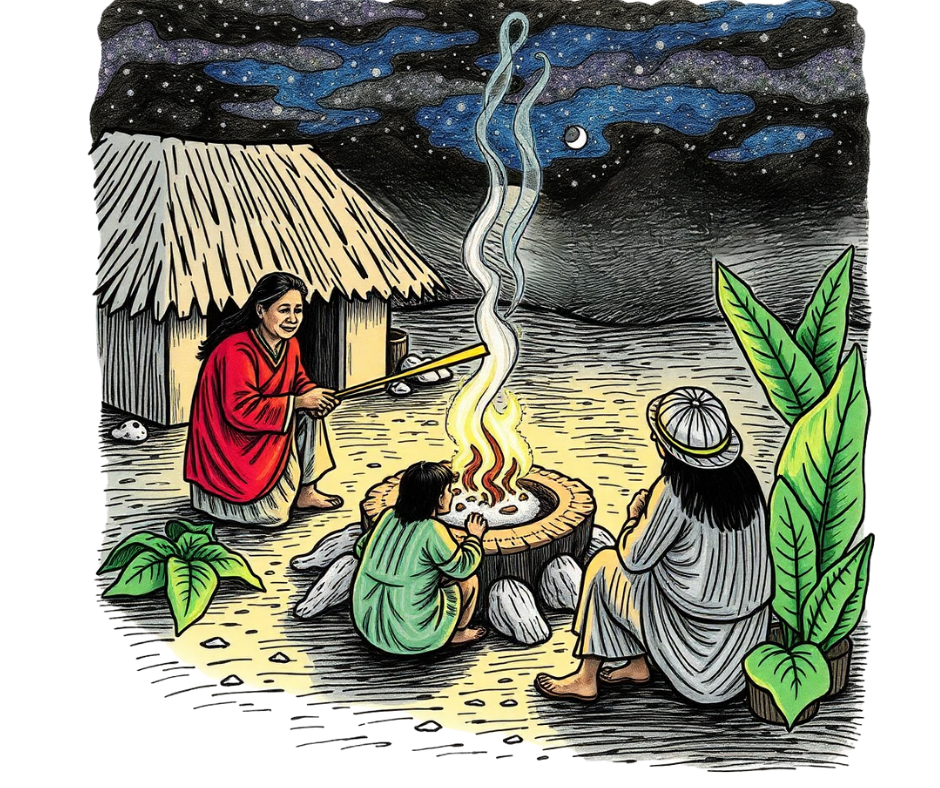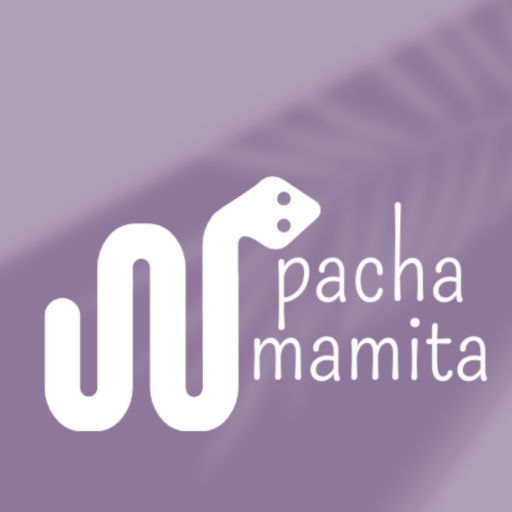The Night of the Leaves
The air on what is now the Ecuadorian coast was then, as it is now, warm and salty. The houses, though very light in appearance due to the bahareque (cane with smoothed mud) and palm roofs with which they were built, also had sturdy posts, revealing the light emanating from a soft, cozy fire.
On a small basket sweetly placed at her side, three things rest: coca leaves of an intense dark green color, a small container with llipta (light lime powder or ash) and a polished spatula.
The most experienced person in the group guides those gathered around the fire with their love and wisdom. Their hands calmly separate the leaves, choosing those that crunch without breaking. They place some in their mouths and arrange them to one side, forming a ball on their cheeks. With the spatula, they take a pinch of llipta. The leaf "awakens": the body releases fatigue, hunger calms, and attention sharpens. Thousands of years ago, chewing coca in Ecuador wasn't about escaping the world; it was about entering it more fully.

A boy stares at the spatula the older boy is still holding, his eyes wide open; his grandmother tells him the order of the steps, but with gestures and almost without words.
Another participant in this gathering arranges a woven mat; another person tightens a tie on the palm thatch roof so that the smoke rises in threads and doesn't burn. The surrounding houses are light and sturdy: inside, they are a framework of reeds, covered with mud kneaded with water and patience. If the wind picks up or the earth trembles, the house accompanies the movement; and then, it is repaired with what the land provides. Nothing is left over, nothing is missing.
—Will it rain in time for the corn?
—Will it be a good day to travel?
—How do you accompany someone who can’t sleep?
The questions are clear. No one expects a thunderclap to command; the answers arrive like waves: one after another, small, until the water writes a line in the sand. Several people's cheeks round out, a sign that the leaf is working. Some people leave three leaves fanned out on a smooth stone; others offer the earth a pinch of the ball. It's both giving thanks and asking permission.
As the hours pass, the first colors of dawn begin to appear, accompanied by the scent of the sea. On a mat, young and old hands mend a net; others begin to repair a wattle and daub cloth with fresh mud. Coca also travels in a woven bag, shaded, ready for the journey: a few leaves and a pinch of llipta make the difficult journey shorter. The same leaf that opens the ear at night sustains the body by day. Everything is woven like reed and mud on the wall, like toquilla fibers on hats and baskets: work and advice have always been there, always to come together in the same conversation.
Archaeological and ethnobotanical evidence of coca leaf use in pre-Hispanic Ecuador.
Lime containers (phase 4, ca. 2100 BC)
Small ceramic lime containers have been found associated with Valdivia Phase 4, direct evidence of coking with alkaline activation.
Iconography of the “bulging cheek” (late Valdivia, 1600–1500 BC)
A late figurine shows the swollen cheek typical of the coca chewer, reinforcing the symbolic/ritual use of the plant.
Salango–Engoroy/Bahía (south-central coast, 600–100 BC)
Lime containers and spoons/dippers are documented in the Salango ceremonial complex; the material assemblage links coca chewing with ritual practices and social hierarchy.
Northern Andean highlands (Capulí, 10th–16th centuries AD)
Ceramic pieces with bulging cheeks indicate the continuity of coqueo in the northern Ecuadorian Sierra.
According to records, the coca leaf has served a dual purpose for centuries. In practice, it helps alleviate hunger and fatigue during long days of fishing, planting, or traveling: acullico—slow chewing with a tiny pinch of llipta (lime or ash)—sustains the body without disconnecting it from the world.
Ritually, the same practice encourages concentration and listening in consultations with ancestors and sacred places; it is administered with respect, in small doses, and within a known community order (a summary disseminated by spaces like the Casa del Alabado Museum).
Why do we hardly see it in Ecuador today?
Although coca was cultivated and circulated in pre-Hispanic times and in the early colonial period, its presence gradually faded due to a network of factors: colonial policies against indigenous practices, economic changes that altered routes and interests, and in the 20th century, increasingly strict legal prohibitions that even outlawed the genre. Erythroxylum (the so-called “1990 Law”, analyzed by Hirschkind, 2005, in Ethnobotany Research & Applications). The result: a once everyday and ritual plant became, in much of the country, a material memory in figurines, llipta containers, and community stories.
Frequently Asked Questions About the Use of Coca Leaves in Ecuador
The coca leaf is an Andean plant with several alkaloids and traditional uses; cocaine is an alkaloid isolated and concentrated in modern times. They are not the same, nor do they have the same effects or contexts.
No. It's traditional lime or ash in minimal amounts; its purpose is to alkalize the mouth to better extract the leaf's compounds, which is why it's applied with a spatula.
There is early evidence on the Ecuadorian coast: in Valdivia (Formative), figurines with bulging cheeks—a sign of acullico—and vessels associated with llipta appear; there are even older indications of alkalizing agents in pre-ceramic contexts.
Because of the bulging cheek (bolo) and, sometimes, because of the utensils (llipta container + spatula); there are clear examples in the Valdivia culture.
Slowly chew coca leaves into a lump in your cheek and add a pinch of llipta (lime/ash) to activate its compounds.
On the Coast (Bahía, Jama-Coaque, La Tolita) and in the northern Andes/piedmont (Cosanga, Panzaleo, Capulí/Piartal), images of coca farmers and associated tools are recorded.
Mainly Erythroxylum coca var. coca (humid environments) and E. novogranatense var. Truxillo native (drier), as well as wild species.
Mainly Erythroxylum coca var. coca (humid environments) and E. novogranatense var. Truxillo native (drier), as well as wild species.
Modern laws prohibited the cultivation and use of species of the genus Erythroxylum; that's why the cultivation is almost invisible today, although the memory remains in objects and stories.
Bibliography and recommended links
Bibliography and recommended links
-
House of Praise Museum (Quito) – Informative note on coca and llipta (ritual/therapeutic uses; administration by specialists). House of Praise Museum
-
Bauer, I. (2019). Travel medicine, coca and cocaine. Trop Dis Travel Med Vaccines (open access): function of the llipta (lime/“ash”) and differences between leaf vs. cocaine. PMC
-
The Met, “Coca chewer on bench” (Capulí) – Iconography of the bolus on the cheek (Ecuador/Colombia), 800–1500 AD The Metropolitan Museum of Art
-
UNESCO (2012) – Traditional weaving of the Ecuadorian toquilla straw hat (Intangible Cultural Heritage). PCI – Intangible Cultural Heritage
-
Hirschkind, L. (2005) – The Enigmatic Evanescence of Coca from Ecuador (on prohibitions and disappearance of the crop in the country). Ethnobotany Journal
![]()
